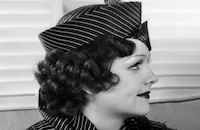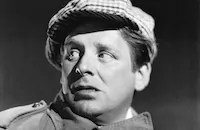Mary Burns, Fugitive

Brief Synopsis
Cast & Crew
William K. Howard
Sylvia Sidney
Melvyn Douglas
Alan Baxter
Pert Kelton
Wallace Ford
Film Details
Technical Specs

Synopsis
Mary Burns, who runs a country diner, falls in love with thief and killer Don "Babe" Wilson, believing he is an oilman. When Babe arrives from New York with his partner to retrieve a stash of bonds from the diner, he asks Mary to marry him that night and spend a honeymoon in Canada. Babe has been followed by G-men, however, and a shootout ensues in which Babe shoots a G-man. Babe escapes, but Mary is apprehended as his gun moll. During the trial, Mary is coerced by the prosecutor into confessing she was Babe's accomplice and is sentenced to fifteen years in state prison. After three months in jail, Mary's blonde roommate, Goldie Gordon, once a moll but now an informant for the authorities, helps Mary escape with her. Meanwhile, Babe and his accomplice, "Spike," try to locate Mary because Babe is still obsessed with her. Mary and Goldie get an apartment, which the G-men bug, and Goldie tries to get Mary to confess Babe's whereabouts, but she does not know where he is. Mary, using the alias "Alice Brown," gets a night job in the kitchen of Mercy Hospital, where she meets cantankerous patient Barton Powell, an explorer who is suffering from snow-blindness. When Barton tastes Mary's excellent coffee, he orders her to be his private nurse and she reads to him daily. They fall in love, and he invites her to do secretarial work at his secluded cabin at Lake Marquette, where he will be finishing a book. Meanwhile, Spike arrives at Mary's flat and orders her to accompany him to Babe. The G-men intervene and shoot Spike, and Mary flees the flat and hides in Barton's hospital room. Barton again asks her to come with him and swears his love, but she says good-bye and hops a train to Utah. While the police close in on Babe, he tracks Mary and, armed with a hand grenade in a church in Salt Lake City, forces Mary into his car. A nationwide manhunt ensues, but the couple eludes the police. Mary becomes a taxi dancer in a nightclub in Colinsburg, and one night, a G-man dances with her and outlines a scheme to get Babe. Mary is ordered to write to Babe telling him she has fled to Barton's cabin at Lake Marquette. When Mary refuses to involve Barton, who now knows her true identity, the G-men forge the letter. Harper, from the Department of Justice, arrives at Lake Marquette and tells Barton he, too, believes Mary is innocent. Mary then arrives and Barton, who has regained his sight, sees her for the first time and promises to go to Washington to clear her name. Babe enters and orders Mary at gunpoint to embrace and kiss him. When Babe shoots Barton in the shoulder, Mary pulls the trigger on the gun in Babe's coat pocket and he falls dead. Barton, again in the hospital, makes the headlines as a national hero and secures Mary's pardon. When he drinks his coffee, he knows Mary is close by, and after she enters, they kiss.

Director

William K. Howard
Cast

Sylvia Sidney

Melvyn Douglas

Alan Baxter

Pert Kelton

Wallace Ford

Brian Donlevy
Esther Dale
Frank Sully
Boothe Howard
Norman Willis
Frances Gregg
Charles Waldron
William Ingersoll
Rita Stamwood Warner
Grace Hale
Daniel Haynes
Joe Twerp
William Pawley
James Mack
Isabelle Carlisle
Henry Hall
Dorothy Vaughn
Esther Howard
Morgan Wallace
Phil Tead

Ann Doran

Fuzzy Knight
Max Waggner
Gertrude Walker
Treva Lawler
Charles Wilson
George Chandler
Sammy Finn
Richard Pawley
Bert Hanlon
Cora Sue Collins
Otto Fries
Earl Eby
Gus Reed
Walter Downing
Kernan Cripps
Ivan Miller
Bob Reeves

Robert Walker
Walter Shumway

Jack Mower
Tom Ford
Patricia Royale
Beverly King
Grace Hayzell
Virginia George
Doc Merman
Crew

Film Details
Technical Specs

Quotes
Trivia
Notes
According to ads for this film, Alan Baxter's character was based on real-life criminal Don "Babe" Wilson, "an ex-college hero and all-American football star." The Daily Variety preview length for the film was 68 minutes. The Hollywood Reporter reports from London on November 30, 1935 that the film was passed by British censors only after the entire sequence of an attempted arrest in a church had been cut. According to an April 1936 Hollywood Reporter news item, this film was banned by the Australian censors, but Paramount lodged an appeal for reconsideration of a reconstructed version of the film.
"I'm in the Mood for Love," lyrics by Dorothy Fields, music by Jimmy McHugh, plays on Mary's radio while she waits for Babe to arrive in the beginning of the film. The plot description in Motion Picture Herald's "Cutting Room" column has Mary marrying Babe before being jailed.
This film marked the motion picture debut of actor Stanley Morgan, who acted for several years under that name before changing it to Dennis Morgan, the name which he used for the remainder of his career. Morner was under contract to M-G-M in 1936 and 1937. His greatest success, however, was at Warner Bros., the studio for which he worked in the late 1930s through the early 1950s.













